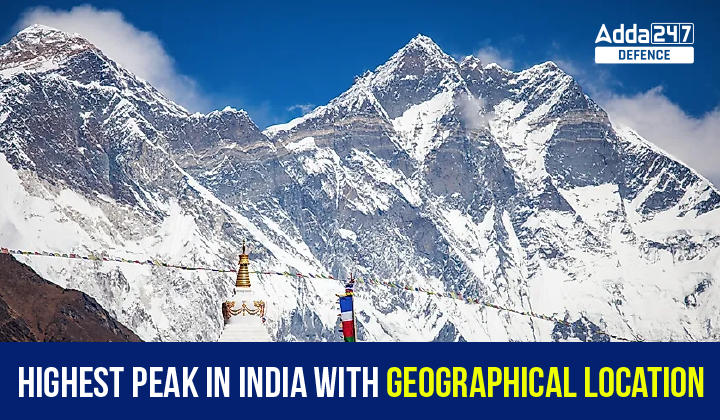Highest Peak in India
India, known for its diversity in various aspects, showcases a wide range from landscapes to cultural heritage. The northern expanse is predominantly mountainous, presenting an incredible variety of geographical wonders. Among these wonders, the towering peaks of the Indian Himalayas stand out, capturing the fascination of explorers and nature lovers. Among these majestic mountains, there lies the highest peak in India, representing magnificence and symbolizing the country’s rich geographical variety. Exploring this remarkable summit and its specific location reveals an incredible journey into the heart of India’s geographical location.
Top 5 Highest Peaks in India
Gazing towards the heavens, our attention is drawn to the mighty Kangchenjunga, the crown jewel of the Indian Himalayas. Ascending to an awe-inspiring elevation of 8,586 meters (28,169 feet), Kangchenjunga stands tall as the third-highest peak in the world. Its name, derived from the local Limbu language, translates to “Five Treasures of Snows,” symbolizing the five majestic peaks that converge to form this imposing mountain.
| 1 | Kanchenjunga | 8586 meters |
| 2 | Nanda Devi | 7816 meters |
| 3 | Kamet | 7756 meters |
| 4 | Saltoro Kangri | 7742 meters |
| 5 | Saser Kangri | 7672 meters |
List of Highest Peaks in India
India is a beautiful country with many different types of land. It has tall mountains that reach up into the sky. These mountains are part of the Himalayas, and they are very special. One of the mountains is the highest in India. It is very tall and impressive, and people love to climb it. Join us on a thrilling journey as we unravel the mysteries of this extraordinary summit and explore its geographical location.
1. Kanchenjunga
Looking at the political map of India, K2 also known as Godwin Austin is the highest peak in India, but it comes under POK so when we talk about the highest peak in India we consider Kanchenjunga as the highest peak, located at the border of Nepal and Sikkim is taken into account. It is the third-highest mountain in the world with an elevation of 8586 meters above sea level.
Kanchenjunga is a Tibetan term which means “The five treasures of high snow”. The treasures are Gold, Silver, Gems, Grain and Holy Books. Kanchenjunga also provides its serene countryside and woody forests for eyes which seek solace in nature.
Height: 8586 Metres.
Location: Sikkim.
2. Nanda Devi
Nanda Devi is part of the Garhwal Himalayas, nestled in the state of Uttarakhand, between the Rishiganga valley on the west and the Goriganga valley on the east Nanda Devi in local parlance, she is the patron – goddess of the Uttarakhand Himalayas. And is revered by the people residing here hence the Nandadevi peak is considered sacred, In view of its religious significance and the delicate EcoSystem it preserves, Mt. Nanda Devi sanctuary was closed to climbers and others in 1983. The surrounding Nanda Devi National Park was declared a UNESCO World Heritage Site in 1988.
Height: 7816 Metres
Location: Uttrakhand
3. Kamet
It is located in the Chamoli district of Uttarakhand, having an inspiring elevation of 7,756 meters. After Nanda Devi, it is considered the second tallest peak in the Garhwal region of Uttarakhand. When seen from a distance, it geographically resembles a pyramid topped by a flat summit.
Situated in the Chamoli district of Uttarakhand, Kamet Peak is part of the Zaskar Range, a subrange of the Garhwal Himalayas. It lies near the border between India and Tibet, in close proximity to other renowned peaks such as Mana, Abi Gamin, and Mukut Parbat. The surrounding region boasts stunning landscapes, alpine meadows, and glacial valleys, making it a paradise for mountaineers and nature enthusiasts.
Height: 7756 metres
Location: Uttrakhand.
4. Saltoro Kangri
Saltoro Kangri is the highest peak of the Saltoro range of the Karakoram Himalayas. Saltoro Kangri I is the 31st highest mountain in the world. It is located between the actual ground position between India and Pakistan in the Siachen area.
. It gained international recognition in 1962 when a joint Indian and British team, led by Lieutenant Colonel Narendra Kumar, successfully summited the peak for the first time. This historic achievement put Saltoro Kangri on the map of renowned mountaineering expeditions, further fueling the allure of the region.
Height: 7742 Metres
Location: Jammu and Kashmir.
5. Saser Kangri
Saser Kangri is a group of mountains, located in the eastern Karakoram range of Ladakh union territory of Nubra valley. In the local luggage of Ladakh, Saser means Yellow and kangri means snow-covered peak.
Saser Kangri gained international recognition in 1973 when an Indo-Japanese expedition successfully summited the peak for the first time. Since then, it has captured the attention of mountaineering enthusiasts from around the world. The mountain’s challenging nature, coupled with its pristine beauty, has made it a sought-after destination for climbers seeking to test their skills and endurance.
Height: 7,672 metres
Location: Jammu & Kashmir.
List of Highest Mountain Peaks in India
In addition to the five highest peaks in India, there are many other major mountain peaks in the country. The following table lists the mountain ranges in India, the states in which they are located, and their heights:
| Peak | Range/ Region | State | Height |
| Arma Konda | Eastern Ghats | Andhra Pradesh | 1680 m |
| Kangto | Eastern Himalaya | Arunachal Pradesh | 7090 m |
| Someshwar Fort | West Champaran District | Bihar | 880 m |
| Bailadila Range | Dantewada District | Chhattisgarh | 1276 m |
| Sosogad | Western Ghats | Goa | 1022 m |
| Girnar | Junagadh District | Gujarat | 1145 m |
| Karoh Peak | Morni Hills | Haryana | 1499 m |
| Reo Purgyil | Western Himalaya | Himachal Pradesh | 6816 m |
| K2 | Karakoram | Jammu and Kashmir | 8611 m |
| Parasnath | Parasnath Hills | Jharkhand | 1366 m |
| Mullayanagiri | Western Ghats | Karnataka | 1925 m |
| Anamudi | Western Ghats | Kerala | 2695 m |
| Dhupgarh | Satpura | Madhya Pradesh | 1350 m |
| Kalsubai | Western Ghats | Maharashtra | 1646 m |
| Mount Iso | Senapati District | Manipur | 2994 m |
| Shillong Peak | Khasi Hills | Meghalaya | 1965 m |
| Phawngpui | Saiha District | Mizoram | 2165 m |
| Mount Saramati | Naga Hills | Nagaland | 3841 m |
| Deomali | Eastern Ghats | Odisha | 1672 m |
| Unnamed point on the Naina Devi | Rupnagar District | Punjab | 1000 m |
| Guru Shikhar | Aravali | Rajasthan | 1722 m |
| Kanchenjunga | Eastern Himalaya | Sikkim | 8598 m |
| Doddabetta | Nilgiri Hills | Tamil Nadu | 2636 m |
| Laxmidevipalli | Deccan Plateau | Telangana | 670 m |
| Betalongchhip | Jampui Hills | Tripura | 1097 m |
| Amsot Peak | Shivalik Hills | Uttar Pradesh | 957 m |
| Nanda Devi | Garhwal Himalaya | Uttarakhand | 7816 m |
| Sandakphu | Eastern Himalaya | West Bengal | 3636 m |
Himalayas and Defence
History is the sole witness of how many times the Himalayas saved the Indian continent from foreign invasions, acting as a compound wall between India and other East Asian countries. During the nationalistic movement, the Himalayas were the epitome of bravery and were presumed to be the crown of Bharatmata, and it is a well-established fact that the Indian army is the best army when it comes to mountain warfare.
The Himalayas hold immense strategic importance for India due to their proximity to sensitive areas and strategic landmarks. The mountain range encompasses regions such as Ladakh, Sikkim, and Arunachal Pradesh, which have witnessed border disputes and tensions with neighboring countries. India’s military presence and infrastructure development in these regions are vital for maintaining territorial integrity and protecting national interests.
The Himalayas’ unique terrain presents distinctive challenges for military operations, particularly in mountain warfare. India has developed specialized mountain warfare units and training facilities to equip its armed forces with the necessary skills and knowledge to operate effectively in these harsh and demanding environments. These units undergo rigorous training in survival, acclimatization, and combat techniques specific to mountain warfare.
Recognizing the strategic importance of the Himalayas, India has been focusing on enhancing border infrastructure to strengthen its defense capabilities. Infrastructure development includes building roads, airstrips, and bridges to improve connectivity and mobility for military deployments in the mountainous terrain. The construction of strategic roads and border outposts helps in enhancing surveillance, rapid troop movement, and quicker response times.
Hence the highest peaks of India are not just for the scenery, they are the strategically prominent areas under the possession of India.
Also, Check:




 CDS Previous Year Question Papers, Downl...
CDS Previous Year Question Papers, Downl...
 AOC Result 2025 Out, Download Link Activ...
AOC Result 2025 Out, Download Link Activ...
 NDA 1 Admit Card 2025 Out, Download NDA ...
NDA 1 Admit Card 2025 Out, Download NDA ...












